Newlywed Game, The
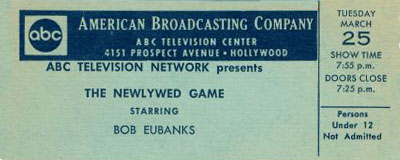
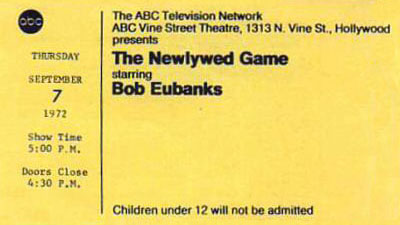
A friend of mine told me that once when he and his wife needed new furniture, they rehearsed a little routine in which they embarrassed each other by revealing “secrets” which they made up for the occasion. Like, they decided to blurt out that the husband liked to dress in the wife’s clothing, and that her cooking gave him diarrhea at least once a week. Then they went and auditioned for The Newlywed Game, quarrelling the entire time and letting such things “slip.” They were instantly booked as contestants.
Once in front of the cameras, they dropped the act and behaved like dignified human beings, despite the fact that the questions they were asked seemed calculated to evoke the humiliating stories from the audition. They left with their self-esteem relatively intact, plus a new bedroom set. They also received a tongue-lashing from the show’s Contestant Coordinator who realized they’d been “had,” and warned them that they would never get on another Chuck Barris game show as long as they lived. So far, it hasn’t bothered them too much. (The top ticket, by the way, seems to be from 1969.)
Queen for a Day
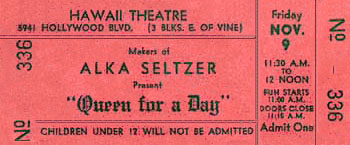
Queen For A Day was an offensive, voyeuristic show that capitalized on the misery of its contestants, and I’m surprised no one has tried reviving it lately. Basically, a number of women were paraded on camera each episode to tell why they should be named “Queen For A Day” and awarded a big prize package. Ostensibly, that honor was to go to someone who’d done something to deserve it, but the show usually devolved into the ladies telling about how awful their lives were; how their husbands had left them or died and how their mother was ill and how the roof on their home was collapsing, etc. Somehow, went the premise, some of this would be put right and their lives set on a happier course if the show’s studio audience would vote them “Queen For A Day” which meant they’d get crowned with a tiara and sent home with a box of small appliances. There were a lot of tears, and I guess America’s homemakers liked to watch and cry along, and think, “Thank God that woman has it worse than me,” or something of the sort. An awful spectacle, especially when you considered all the women who cried and poured their hearts out on network TV and didn’t even win the Waring Blender and the case of Noxzema that the winner got.
The show moved around to various studios in Hollywood, broadcasting for a time from (as above) the Hawaii Theatre , which was another of Sid Grauman’s “international” film palaces. The Chinese and The Egyptian were, and still are, further west on Hollywood. The Hawaiian is now a Salvation Army church. I’m guessing the above ticket is from 1953, when the show was seen only on television in Los Angeles. It went network in 1956 on NBC, moved to ABC in 1960 and finally went off in 1964.
Entertainers, The
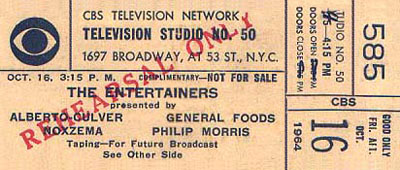
The Entertainers probably sounded like a good idea –a variety show starring not one but three stars: Bob Newhart, Carol Burnett and Caterina Valente. Each week, one, two or all three of them would perform songs and sketches, working with a crew of rotating special guest stars that included Ruth Buzzi, John Davidson, Dom DeLuise, Don Crichton, and newspaper columnist Art Buchwald. At times, it was difficult to tell the stars from the guest stars, and the lack of focus seemed to keep audiences at bay. Eventually, Newhart departed and a concerted attempt was made to feature Burnett and Valente as co-hosts — but they had little chemistry and by then, it was too late. The show was cancelled after seven months and the only one who profited from the experience was Carol Burnett. CBS signed her to a long-term contract for specials and guest appearances, and this eventually led to The Carol Burnett Show. Newhart, of course, came back later to great success — but among the many biographies and specials that have recounted the careers of Burnett and Newhart, there is almost no mention of The Entertainers. (This ticket was donated to this site by Brian Gari, for which we thank him kindly.)
Krofft Superstar Hour
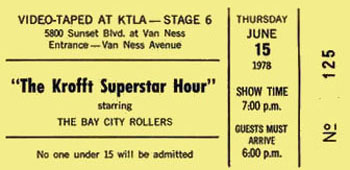
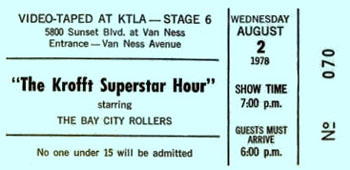
I was actually one of the writers for this one, which was produced for NBC’s 1978 Saturday morning line-up by Sid and Marty Krofft. That season, the whole schedule was pretty much a disaster so after a few weeks, they switched some shows around, dumped others and the Krofft Superstar Hour was chopped down to a half-hour called The Bay City Rollers Show. In its shortened form, it stayed on the NBC Saturday morning schedule for a couple years of the same thirteen episodes being rerun over and over and over again. (I don’t think half of the last two hours we produced ever even aired.)
The show featured The Bay City Rollers and an all-star roster of characters from past Krofft shows: H.R. Pufnstuf, Witchiepoo, Seymour the Spider, Stupid Bat, Hoodoo (the villain from Lidsville, played on our show not by Charles Nelson Reilly but by a gent named Paul Gale, who did a darn good impression of him) and others. Jay Robinson, who’d portrayed Dr. Shrinker on the series of the same name, and Billy Barty, who played his assistant, played identical characters under different names. Also in the cast were Louise DuArt, Sharon Baird, Mickey McMeel, Patty Maloney, Van Snowden and voice actors Lennie Weinrib and Walker Edmiston. This show should not be confused with The Krofft Super-Show, which was on ABC a season or two earlier, but quite a few books on TV history don’t seem to know the difference.
When I signed on to work on the show, it was to have been hosted by ABBA — or so said a powerful agent who swore he represented that group and would deliver them. ABBA was at a low point it its/their career and reportedly eager/willing to do a kids’ show for American TV…but negotiations broke down and we instead got The Bay City Rollers, who were on a similar downturn. Our show was, in fact, the “last hurrah” of the group as composed primarily of the original Rollers. Their Scottish accents and awkwardness delivering intros and comedy material had a certain charm, even if it rendered much of what we wrote unintelligible. Still, I got along great with the guys even though they weren’t getting along so well with one another. At the time, one of them was suing the others, so a certain tension hung over the set.
We had an interesting technical problem on the show, in part because the membership of the Rollers had changed from time to time. Almost all the musical performances consisted of the Rollers lip-syncing to records they’d made a few years earlier…and in one or two cases, guys who were currently in the group were performing to recordings that hadn’t involved them, and they were mouthing the words to someone else’s voices. That made their lip-sync work less convincing than it otherwise might have been. Even when a musician performs to his own track, it is not uncommon for them to be a fraction of a second behind the audio so when you can, you go in and slip the picture a few frames later to compensate. Our editors found that they couldn’t do this easily with the Rollers. All five of the guys were moving their lips a quarter of a second late but the drummer, Derek, was right on the beat. Director Jack Regas, who’d done hundreds of hours of musical numbers for TV, said he’d never seen anything quite like it. Even Derek was a tiny bit behind with his singing but his sticks hit the drum in absolute precision…so if we’d moved the vocal tracks to put the lip movements in sync, the visual of him drumming would have been off. The post-production people had to go in and slide the picture only on angles where you couldn’t see Derek…and on shots of him playing and singing, they had to decide which of the two to let be out of sync. They usually opted to keep the drums in time.
The moment tickets like the above were made available, they were immediately gobbled up by a squadron of teenage girls who staked out the studio every day, and occasionally found their way to a house up in Laurel Canyon where one faction of the Rollers was staying. The writers took turns doing the audience warm-ups for the tapings — the easiest job ever in show business. You just had to walk out and say the name of one of the Rollers and the girls in the bleachers, many of whom were clearly under the minimum age listed on the tickets, would scream themselves into a frenzy. (By the way: Industry legend, which is so often wrong, said that Stage 6 at KTLA was where Al Jolson filmed The Jazz Singer in 1929. Longtime TV producer Joel Tator notes that Stage 6 wasn’t even built at the time, and theorizes that Mr. Jolson actually performed on what is now Stage 9. Either way, when I worked there, everyone told us it was “Where Jolson made The Jazz Singer” and one got the feeling the place hadn’t been cleaned much since then.)
Our Miss Brooks (TV)
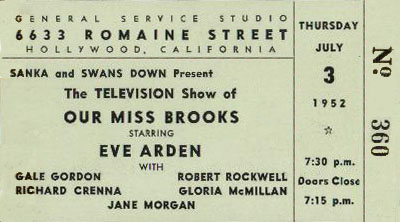
In 1951, I Love Lucy went on TV, not only becoming a smash hit but inventing the way most situation comedies would be filmed thereafter — in front of a live audience with multiple cameras. The show was produced by Desilu, a company owned by Desi Arnaz and Lucille Ball, and they were quickly asked if their studio and methods could be employed for other shows. The first new one they took on was the TV adaptation of the radio show, Our Miss Brooks,. which was filmed on the same stage used for I Love Lucy on other days. The TV version of Our Miss Brooks went on the air October 3, 1952 so the above ticket is probably for one of the very first filmings, maybe even the first.
It was a period when many popular radio shows were being transferred to television but Our Miss Brooks was different from most. For one thing, it employed pretty much the same cast. Most programs recast because the radio actors didn’t always look the way they sounded…but Eve Arden, Gale Gordon, Richard Rockwell, Richard Crenna and all the rest were suitable for their roles. (Buying Crenna as a teenager was a bit of a stretch — he was 26 at the time — but they got away with it.) Also unusual was that the same producers and cast continued to do the show for radio every week for many years.
The TV show was a modest hit for its first three years. Audience enjoyed watching high school English teacher Connie Brooks (Arden) battle with the school’s principal, Osgood Conklin (Gordon) while she lusted after the handsome Biology teacher, Mr. Boynton (Rockwell). But when ratings dipped in 1955, the show underwent a revamp. Miss Brooks and Mr. Conklin moved from Madison High to a private elementary school where they were surrounded by a new supporting cast. The change failed to boost tune-in and that was the last season. The show went off in 1956, the same year a feature film of Our Miss Brooks was released. It was set back in the high school and ended with Miss Brooks and Mr. Boynton finally getting married, thereby ending the series, once and for all.
Our Miss Brooks (Radio)

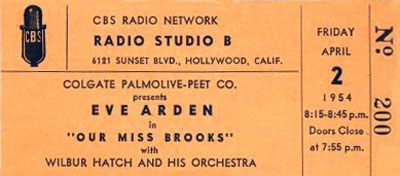
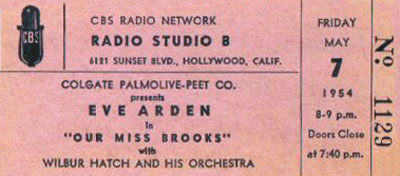
For years, Eve Arden made a pretty good living playing sarcastic, wise-cracking second leads in movies. She even got an Oscar nomination in 1945 for her role in Mildred Pierce. But around that time, she decided it was time to broaden her appeal and try to get some lead roles and parts that were less abrasive. She managed both with the hit radio show Our Miss Brooks, which went on the air in 1948. It cast her as Connie Brooks, an English teacher at Madison High School who struggled with wayward students and red-tape bureaucracy. Connie was a bit nicer than most of the characters she’d played before, which is to say she only skewered people now and then.
Sharing the mike with her were veteran comic actor Gale Gordon (as the school principal, Osgood Conklin), Robert Rockwell (as Biology teacher Philip Boynton), Richard Crenna (as gawky student Walter Denton) and a wide array of good character actors as pupils and faculty. Wilbur Hatch, whose name is familiar to everyone from the I Love Lucy credits, conducted the orchestra.
Our Miss Brooks aired on Sunday nights. The first ticket above from 3/8/53 is for a live broadcast done from the CBS studio on Vine Street. The other two tickets are from 1954, by which time the show was being recorded Friday evenings at the CBS facility on Sunset for transmission the following Sunday evening. It lasted on the air until 1956, by which time it had already made a successful transition to television with pretty much the same cast.
Match Game, The (1973-1982)
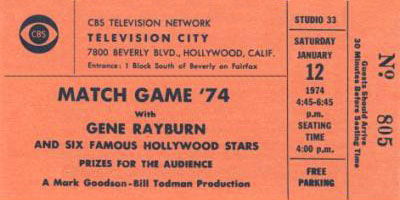
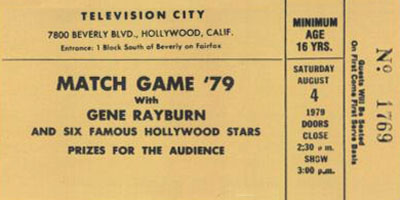
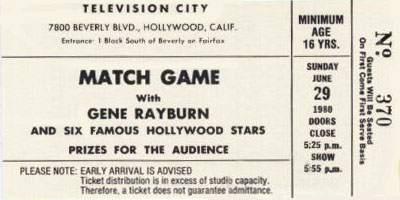
Not long after The Match Game went off NBC, Goodson-Todman Productions was developing a new version for CBS. Hollywood Squares, with its nine celebrities giving funny answers to questions, was then the big hit in daytime TV and the show to copy. The new format Match Game used six but as with Squares, two contestants would compete to evaluate the stars’ responses. The questions also became more likely to lead to funny, slightly naughty answers. Instead of asking people to name their favorite cheese, as he had on the old version, Rayburn would read the straight line to a joke and the celebs would have to supply the punch line.
Match Game ’73 went on the air July 2, 1973. The first panel consisted of Michael Landon, Vicki Lawrence, Jack Klugman, Jo Ann Pflug, Richard Dawson and Anita Gillette. Dawson was a regular from the start…until mid-’78 when he became too busy with Family Feud — a show that seems to have been inspired by the “audience match” bonus round on Match Game. Charles Nelson Reilly and Brett Somers Klugman (ex-spouse of Jack) first appeared on the panel in the show’s third week and soon after came back as regulars.
For a long time, the daytime version changed names every year — to Match Game ’74, then Match Game ’75 and so on. A once-a-week syndicated version for evenings was called Match Game PM and ran from 1975 to 1981. In 1979, CBS cancelled the daytime version and Goodson-Todman immediately offered a syndicated five-a-week version called simply Match Game, with no identifying date since shows were run and rerun at different times. (The tickets above that lack the CBS eye were from tapings for syndicated shows. CBS policy was to only put their logo on tickets for shows that aired on CBS.)
Episodes were taped in long blocks to accomodate Gene Rayburn, who commuted from a home on the East Coast. Sometimes, they’d tape six days a week, five shows a day, for two or three weeks at a stretch. That sometimes made it difficult to secure enough of an audience to fill all the seats. As you can see, the tickets promised prizes to those who came to watch. And on almost every tape day, people dispensing free tickets could be found over at Farmer’s Market, the tourist attraction located next to CBS Television City. Sometimes, they’d “sell” the evening tapings by pointing out that the celebrity panelists often got a bit tipsy over the dinner break from wine and other spirits. This is why the Thursday and Friday shows, which taped after supper, were usually funnier and full of bleeps.
Even after the syndicated version ended, Match Game did not stay off the air for long. By October of ’83, it was back on network as one half of The Match Game-Hollywood Squares Hour, thereby partnering with the show it tried to emulate in the first place. Another version ran from 1990 to 1991 and yet another from 1998 to 1999.
[Thanks to Curt Alliaume for correcting an error that was in this page as originally posted.]
Match Game, The (1962-1969)
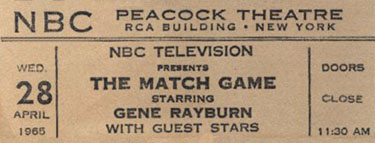
Here’s the first version of The Match Game, which was a simpler show, less prone to dirty answers and drunken celebrities than the revival that followed. In this one, there were two competing teams, each with a celebrity and two civilians. Host Gene Rayburn would ask a question which could have multiple answers like, “Name a great magician” or “Besides pepperoni, what’s a great topping for pizza?” All six people would write down, then unveil their answers. On each team, if two of them matched, they earned $25. If all three matched, they got $50. The first team to reach $100 won the game and a hundred dollars and the right to play the Audience Match for additional cash. The show went on the air the last day of 1962 and lasted until September of ’69. Less than four years later, the revised version went on the air as Match Game ’73.
Jeopardy! (1964-1975)
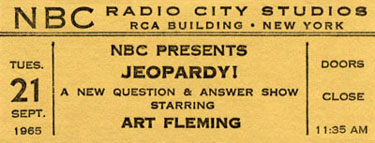
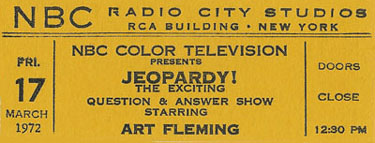
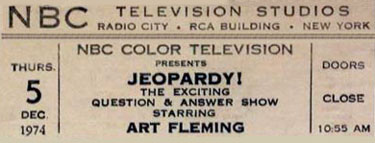
A popular staple of late night comedy shows was always the bit where they give the answer and then the question. Steve Allen did it as The Question Man, and Johnny Carson did the exact same thing as Karnak the Magnificent. (“The answer is…Sis Boom Bah. The question is: Describe the sound of a sheep exploding.”) Under the contract of The Merv Griffin Show, his failed NBC afternoon talk show, Merv was owed a couple of commitments for game shows. He originally tried to assemble a comedy quiz program based on the answer-before-the-question premise but it didn’t come together. At the suggestion of his then-wife, he made it a non-comedy show and defied the notion that daytime TV viewers wanted fluff, not hard questions. In no time at all, Jeopardy! became one of the greatest success stories in the history of television. It debuted in March of 1964 and lasted on NBC until January of 1975, so the third ticket above would have been to one of the last tapings. Eleven years is a hefty run but Griffin was still angry at the time, feeling his “baby” could have run much longer.
A lady named Lin Bolen had taken over in the programming division of the network and she had definite ideas about how to reinvent the stodgy old game show. One was to jettison the “old men” who hosted many of them and bring in “young studs” as hosts. Her theory — and it made sense — was that housewives would rather look at Geoff Edwards and Alex Trebek (who were among her finds) than at Art Fleming and Dennis James. She had other theories as well, and she put them to the test when she developed a new game show called Jackpot! She put her new show in the coveted Jeopardy! time slot, moving that show to a later, less desirable hour. Both shows failed. NBC cancelled Jeopardy!…but under the terms of their contract with Griffin’s company, Merv was owed another year of some show, so he came up with Wheel of Fortune. It debuted the Monday following the last Jeopardy! with one of Bolen’s “young stud” discoveries, Chuck Woolery, as the host. In 1978, after Bolen was no longer at NBC, the network tried bringing Jeopardy! back in a slightly-glitzier format — at Griffin’s insistence, with Art Fleming — but it only lasted five months. Then in 1983, with Wheel of Fortune still doing well on NBC daytime, Griffin launched a syndicated nighttime version. It was a smash so Merv immediately revived Jeopardy!, hired Alex Trebek (one of Lin Bolen’s “young studs,” now considerably older) and sold the two shows as a package. He made a gazillion dollars.
Word for Word
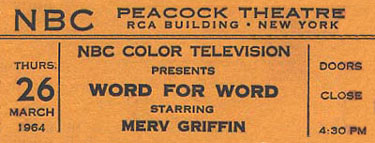
After The Merv Griffin Show left the NBC daytime schedule, Merv returned with a new game show from his own production company. Word for Word involved showing contestants a word and then seeing how many other words they could make using its letters. It lasted a little more than a year before going off but Merv probably didn’t care much. In the meantime, he’d sold NBC a game show called Jeopardy! and soon after, he made a deal to do his own talk show for syndication, so he did just fine. (Ticket courtesy of Brian Gari.)






